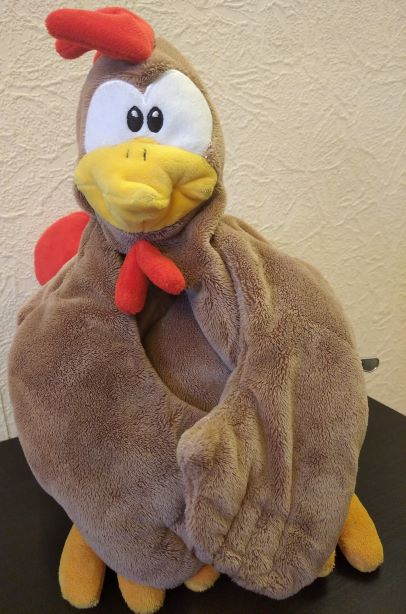
First steps
I still remember my first ever lesson with pre-schoolers in Moscow. I went in prepared, a whole pile of flashcards, crayons, books, mini-cards at the ready. I wasn’t scared or panicky and the thought that we had to occupy ourselves for only 45 minutes was rather soothing. After all, I did teach in Spain, the group was much bigger and the lessons much longer and yet I survived. In a rather victorious manner.
But then the kids came in, only five of them, they sat down nicely and we started the lesson. And by that I mean ‘I’ started the lesson. They did not give me the register before the lesson, the admin left quickly, the door was closed and the parents were somewhere else. I was on my own.
The kids were sitting nicely, very nicely, just looking at me and absolutely not reacting to my smiles, hellos and communication attempts. They did not respond at all to my ‘silly teacher guessing game’ that I normally (and successfully) use to get the kids to introduce themselves at the beginning of the first lesson. I say my name, pointing at myself and then start with one of the kids (the brave-looking one) and start bombarding them with all the boy’s or girl’s names typical of the country that I can think of until I bump into the right one or until the child reacts to the silliness and introduces themselves.
Only this time, I was getting nowhere. Five pairs of eyes were looking at me, just looking at me and waiting for something else. Something else which I did not have. It did last only a minute or even less, in real life, but it felt like a whole eternity. And I did start to panic.
Luckily, among the rubbish that I did bring to class that day, I had a puppet, Max from Playway to English. And guess what, the kids did not want to talk to me but they were more than happy to converse in Max. In English, straight away, even without any special introductions in L1 and explanations that Max is from England does not speak Russian and so we have to make an effort. That was not necessary, they just wanted to talk to him. We did talk. Yay!
I don’t really like puppets, to be honest.
I don’t and I cannot even explain why.
I am actually good at all the puppet-related skils. I don’t have a problem with putting on voices, making faces and role-playing things with myself for the benefit of the 5-year-old audience. And anything in the classroom can find its own soul and voice, flashcards, masks, pencils.
But, really, I use puppets only in the beginning of the course, with new groups, when we have new students joining an already established group or when we were forced to move our pre-primary classes online.
Dex is then ready to help and Teddy sorts out most of the issues. Children feel more comfortable with something that is soft and pretty and right out of the world that they are familiar with and someone who does silly things and who can make them happy. Teddy and Dex are always at the ready.
However, as soon as we done with the first weeks of the course and we feel comfortable in the classroom, they visit less and less frequently. I don’t miss them but perhaps this is something that I should actually reflect on why we are not using puppets more. But there are exceptions, of course.
Angelina, my superhero
It all started in 2017 because this was the Year of the Rooster and, traditionally, the world filled up with toys, figurines, puppets representing this very animal. One of my friends landed one as a present and decided that my classroom will be the best permanent home for it or, actually, her, because, regardless of the Chinese horoscope, it is a she, a hen, Angelina.
At the time, my youngest group were already very big, already five years old, well-accommodated in the school and in the classroom and definitely beyond the stage when they needed a puppet to ‘feel better’ or ‘to break the ice’.
But I had Angelina and I really wanted to use it and, of course, I did. It was not one of the projects that you start with research and reading that lead to implementing an idea in the classoom to meet some specific aims. Here, we went topsy-turvy. I had a resource, I jumped in at the deep end, without any specific aims, observing, taking notes and reflecting. And learning a lot about working with preschoolers. Here is how Angelina changed my teaching life.

Angelina 1: When puppets listen, kids talk.
Instructions
- Get a puppet, think of the name, the background, the voice and the movements. Our Angelina, for example, is not quite a puppet, rather ‘a fancy sweets container‘ as she has a big zipped pocket, in her bum (sorry) which I decided not to use it. I do not to put it on my hand. She normally sits in my lap and I hold her by the back, letting her express herself mostly through the head movements. Sometimes, with the use of my other hand, I use Angelina’s wings or wings which are quite dangly. She is, overall, quite expressive for a puppet))
- Make the puppet a part of the classroom routine. Our Angelina sleeps in her house (this being a rather unappealing plastic bag hanging on the bookshelf). Right after the hello song and hello routine, we wake her up and invite her to join us in the circle. Afterwards, she says goodbye and returns to her house, to continue sleeping.
- The main aim of Angelina’s visits is to provide an opportunity for freer speaking practice and to encourage the kids to produce the language spontaneously.
- In practice that means that we ask lots and lots of questions and Angelina is telling us about herself. We start with ‘What’s your name?’, ‘How are you today?’ and ‘What’s your favourite….?’, later moving on to ‘Do you like…?’, ‘Have you got…?’ and ‘Can you…?’, although these are always only ideas and I make sure that all the contributions are welcome. I have not tried telling and retelling stories yet but that might be another option.
Why we love it
- Angelina (or ‘a puppet’) is a fascinating way of getting the language out of the kids. They start producing the questions because they are really curious about the class puppet’s life and these questions start from the ‘traditional’ questions, often used and heard in class but they quickly become very creative and unexpected.
- Kids naturally react to what Angelina says and we can use this opportunity to teach them and them a chance to express surprise (‘Wow’), disbelief (‘Really?’) or shock (‘Oh no!’).
- There is some opportunity for emerging langauge learning, for example ‘wolf’ (things that Angelina is scared of), ‘corn’ (things that Angelina eats) and ‘planet’ (things that Angelina likes) that we might not have learnt otherwise because they do not really feature in our coursebook.
- It is a woderful opportunity for spontaneous production since with this kind of activities the students are in charge of the content. Naturally, they will not be able to chat freely in English about Angelina (what with being 5, pre-A learners of English, with a limited exposure to L2) but from my perspective (I still teach these same, first Angelina, children, now we are seven and eight and A1 level), this was an important first step that has definitely contributed to my students’ current level of fluency and communicative skills.
Angelina 2: Our class puppet and her diary
Instructions
- First you need to have had a class puppet for some time for the kids to become familiar with the puppets, their habits and interests. I introduced Angeling in year two and the diary in year three, but it will depend on the group and the children.
- The teacher starts the journal. I used a sketchbook and filled in the first few pages with Angelina’s adventures. Each of them was a drawing and a sentence.
- The teacher brings the journal to class. The group look at it together and talk about what they can see in the pictures.
- After a few weeks, the teacher first explains the whole idea and the logictics to the parents: the kids, in turns, will be taking Angelina and the album home for the weekend and then, when they are ready, they will bring them back, with one more drawing added. In class, we are all going to look at it and talk about it.
- To lessen the stress of having to draw in the official diary, I have used a template for the main character, an drawing from clip art library that I printer, cut out and glued to a few empty pages. This way we would always create a collage, the drawing of Angelina would be consistent and of a good quality and the students would only work on the scene itself.
- The kids were only suppsed to write but some of the parents helped and wrote the key sentences.
- When I introduced the idea, one of my eductional mums said ‘Youa are brave!’ and, I guess, by that she meant that I was risking Angelina getting destoryed, lost, stained or loved so much that she would never want to go back to school…Yes, that is something to take into consideration. The younger students might get too emotionally attached and we would be in trouble. Plus, there are the accidents of the everyday that we cannot predict or prevent. I did think about it and I still wanted to risk. Plus, I had located another copy of Angelina in our accountants’ room and I was ready to ask, bribe or steal, should anything really bad happen to our original SuperHen.
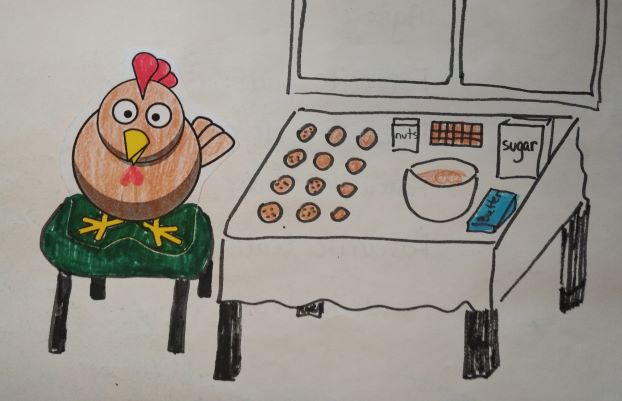
‘Angelina is making cookies’ 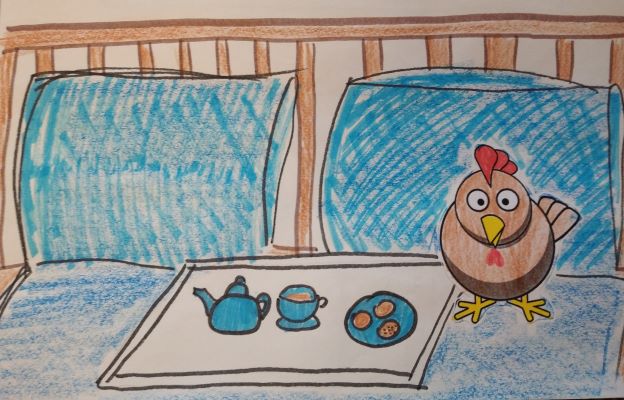
‘Angelina is having cookies and tea.’
Why we love it
- The kids loved taking Angelina home to play. Once she came back to school with a boyfriend (who stayed only for a day) but she also encouraged other kids to bring her toys. A parrot called Pepsi attended our lessons regularly, participated eagerly and sometimes asked for her own handout in order to be able to do her own homework. Which, accidentally, was always different from her human’s homework.
- The project gives the kids a chance to be creative as Angelina can do absolutely anything while visiting. She can go to the park and she can fly to the moon, too.
- It provides the entire group with a picture to talk about, to discuss and to ask questions about and the best bit is – we never know what it is going to be. As a result, we get yet another chance to use the language tools we have to talk and to learn new vocabulary, too.
- No Angelina was harmed during the entire project. The kids took this responsibility very seriously and I was really proud of them.
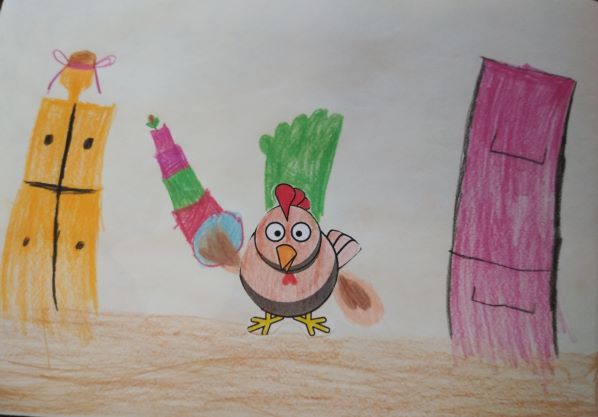
‘Angelina is making a cake’ 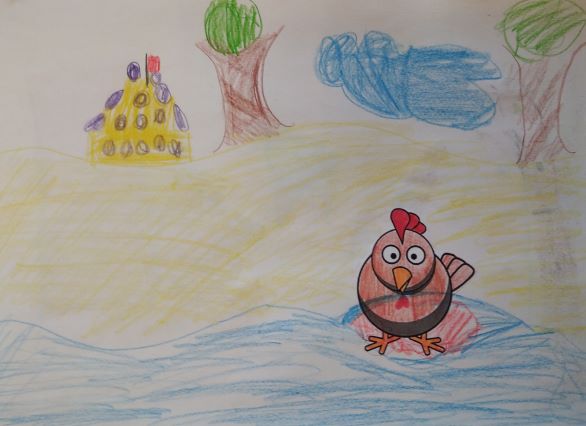
‘Angelina is on the beach’ 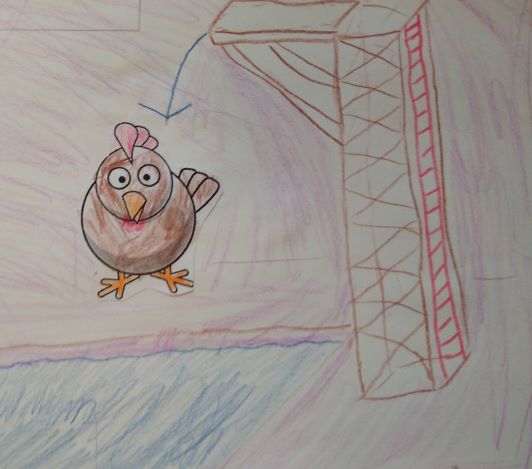
‘Angelina is jumping into the swimming pool’
Instead of a coda, another puppet story.
If you think that puppets and class puppets work only with the little kids, I would like you to reconsider.
In the classroom where we study with my older kids, we don’t have any balls and whenever we need to throw things (while playing games) we use soft toys. For that reason, we have a creature called ‘Flying Cow’, which lives on the top shelf, is a very sphere-like toy cow and, yes, it frequently flies.
Despite the fact that the students are well-past the primary age, Flying Cow always gets stroked, squeezed, hugged, patted, or, in other words ‘is shown affection’. Last year, while we were playing, the cow got thrown or caught rather too energetically and, as a result, suffered a tail injury (reads: it just got ripped off).
It was an interesting thing to see that all my seemingly teenage students gasped in horror at the damage done. As if Flying Cow would really be in pain. I did keep a straight face and acted like a good doctor ‘Don’t worry, everything is going to be alright. I’ll take her home and fix it.’ Which was met with relief.
Maybe not only the little kids?:-)
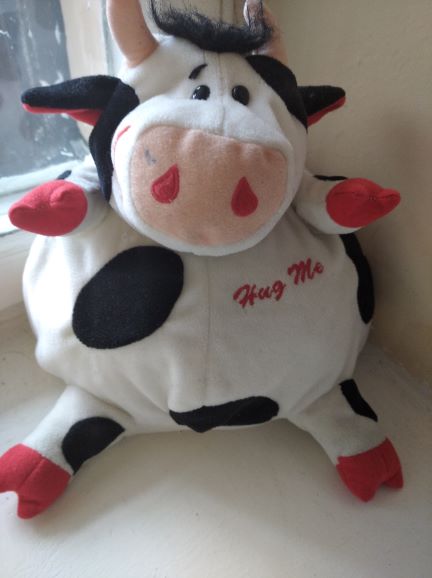
Now, dear teacher, take a careful look around. Is there anyone that could become your Angelina?
Happy teaching!
Bibliography
- Carolyn Webster-Stratton, PhD, Tips for Using Puppets to Promote Preschool Children’s Social and Emotional Development, accessed on 6 January 2021, from www.incredibleyears.com
- Christine Belifiore, Puppets Talk, Children Listen, accessed on 6 January 2021, from https://teachmag.com/archives/5618
- When Puppets Speak, Children Listen, No Strings, TeDxBermuda, accessed on 6 January 2021, from youtube.com
- Sandie Mourão and Gail Ellis, Teaching English to Pre-Primary Children, DELTA Teacher Development Series, pp 48 – 51
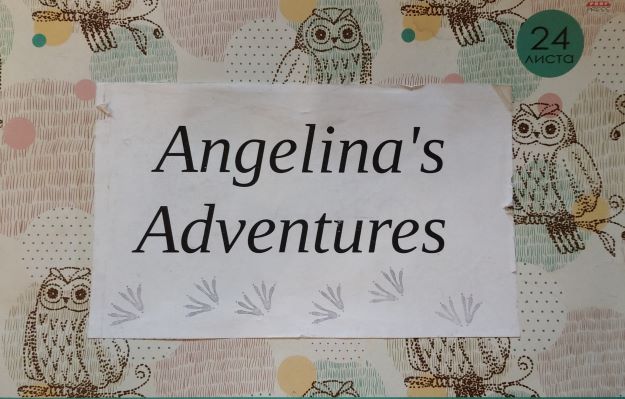

3 thoughts on “Crumbs #13: Angelina, our class puppet.”